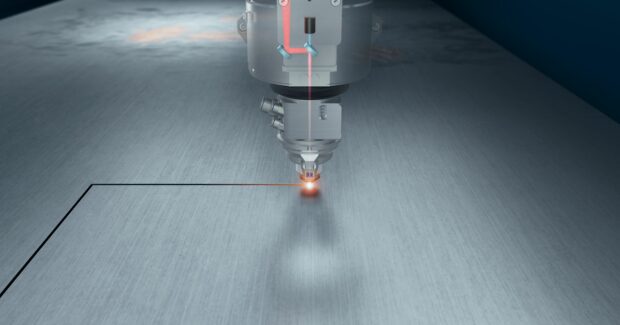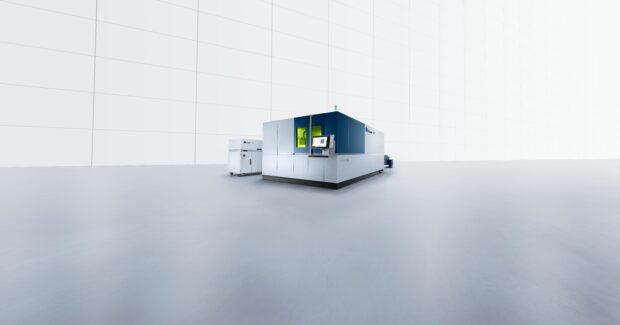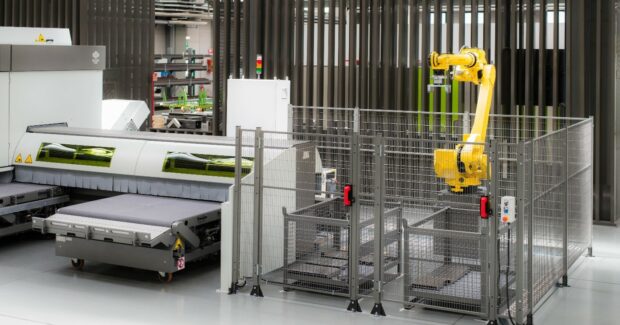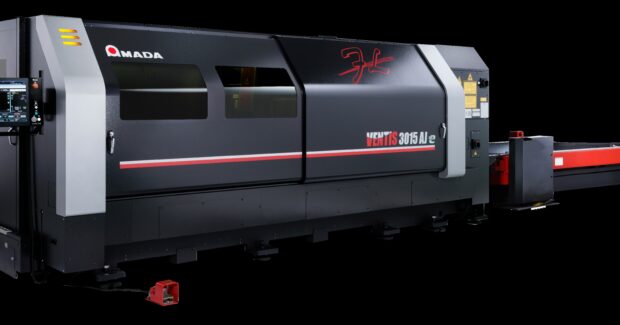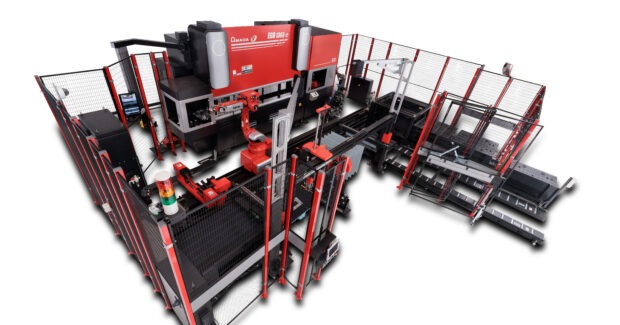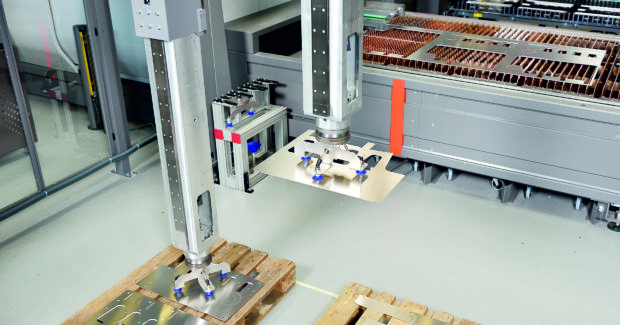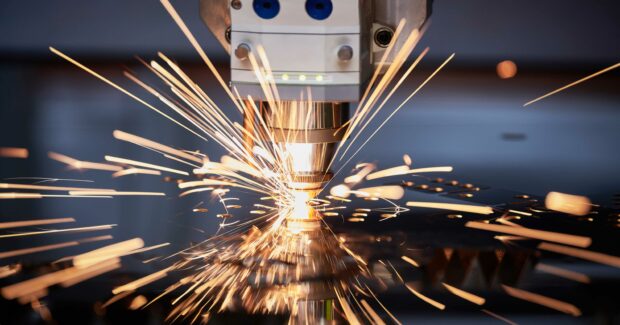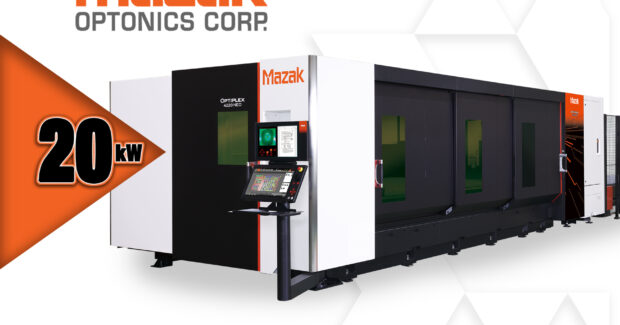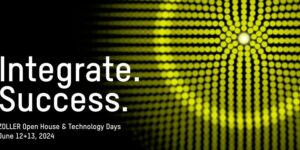Redefining Laser Cutting: What’s Next for Metal Fabrication?
The next generation of laser cutting systems require less operator intervention thanks to automation and robots, freeing up operators to do other tasks.
Posted: November 8, 2023
Fabricating & Metalworking asked leading sheet metal laser cutting machine manufacturers to answer the question: Redefining Laser Cutting: What’s Next for Metal Fabrication? The answers showcase technologies punctuated by artificial intelligence that allow fabricators to do more with less on machines that are easy to operate, no matter the operator’s skill level.
Laser-cutting machines feature intuitive controls that use cameras and microphones to watch and listen to the cutting process. That machine monitoring allows the systems to respond to variations in material thicknesses and quality in real time. Software advances continue to maximize nesting to reduce scrap, connect the machines in your shop so they can communicate with each other, and provide eco-friendly solutions to reduce the use of energy in your process, allowing you to lower emissions — and create premium edge products.
Another area of excitement for end users of laser-cutting systems centers on the next generation of speed – how fast can the lasers go? However, consider higher powered laser-cutting systems require high-speed automation and material handling to keep up with the production — what good does all that power do if the parts are held up from being further processed because the process isn’t designed to keep up? Manufacturers continue to responded with automated cutting and sorting systems that feature robots and automated mobile robots that keep your production humming along efficiently, with less operator intervention.
Below, leading sheet metal laser cutting machine manufacturers share what’s next.
What’s Next? More Power? Logically, It Shouldn’t Be
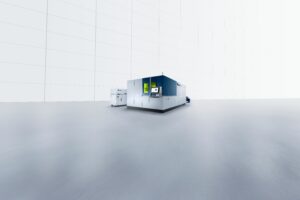
TRUMPF Inc. (Farmington, CT) – Solid state — or 1mµ — laser sources became the standard for cutting sheet metal after gaining mainstream traction among sheet metal manufacturers in 2011. A persistent technology around since the 1960s, these laser sources were new only to our industry. With widespread popularity and use amongst fabricators, the technology has enabled a pace of advancement undreamt-of with the old CO2 vanguard. The most notable aspect of its desirableness was impressive gains in speed, but the simplicity and scalability of the optical chain made it possible to achieve impressive high-power levels, increasing the capacity for fusion cutting, and eliminating that old and aggravating need to remove the oxide layer on parts cut with oxygen as an assist gas.
Now, it’s 2023, and we’ve squeezed amazing productivity out of these machines. But what’s next: more power? Logically, it shouldn’t be. Today’s global economy requires us to address the variable placing North American manufacturers at a disadvantage: the cost of labor. The drive towards ever greater laser powers was an easy way to drive down part costs; the faster I can produce parts, the cheaper the part becomes. Indeed, bolting a bigger laser source to an existing platform is easy enough, but without a well-designed and executed optical chain (e.g., using input coupling, rather than splices) the process becomes less predictable. If you’re making more parts per hour, and those parts go straight into the scrap hopper, does it really count?
TRUMPF has led the market in processing technologies to guarantee stability. Some examples include Active Speed Control — the only proactive cut monitoring system where the laser actually responds in real time to such things as material quality and thickness variations. Likewise, TRUMPF’s unique nanojoints technology allows programs to be run as aggressively as possible, without the possibility of tip-ups and without adding any burden to part sorting. TRUMPF focuses its development in the direction we think is most important: making the most dependable optical chain in the world. From water-cooled positive connectors (in place of spliced connections) to the array of additional protective glasses monitored in real-time with scattered light sensors, to the only closed-loop power measurement system capable of +/- 1% consistency, and all the way down to only 2% of maximum power, only TRUMPF is building an optical chain that can guarantee consistent quality and uptime. — Brett Thompson, laser technology and consulting manager, TRUMPF Inc.
Increased Laser Power, Automation and Eco-friendly Solutions
BLM Group USA (Novi, MI) – Based upon customer needs, automation is the number one area where developments need to be made. With the tight labor market, manufacturers are looking for machines and software to do as much of the thinking as possible so they can delegate their workforce to other areas of the business. Companies want any sort of automation — whether it be towers, load/unload, sorting systems, etc. There will be less operator intervention, more transfers from machine-to-machine with robots, smarter visual systems and more artificial intelligence.
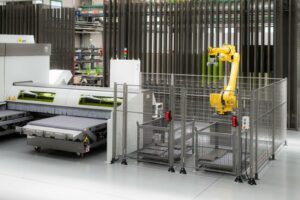
In tandem with that is the need for software platforms that offer the ability to process complex operations through simple-to-use, intuitive interfaces, which are easy for just about anyone to learn. For example, engineering and design platforms that automatically create 3D models simply by dragging and dropping a file into a program folder. With the platform, there will be more machine monitoring with automatic in-process adjustment, as well as connectivity between machines and to higher level ERP programs for enhanced insight and communication across the manufacturing enterprise.
Beyond automating tasks, we are seeing other industry trends that will drive next gen laser systems. These include a focus on more eco-friendly solutions that reduce energy consumption and emissions in laser cutting processes, increasing use of compressed air as the assist gas and the continuing development of higher power lasers. And, lastly, the one thing that never changes is that any new systems need to have an impact on lowering costs in some way. — Gunar Gossard, director of sales, BLM GROUP
Balancing Laser Cutting Systems to Process Product Quickly and Accurately
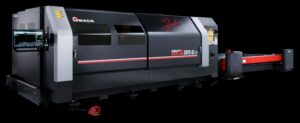
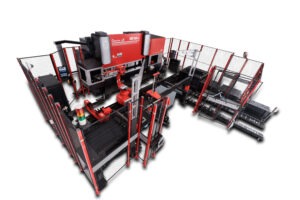
AMADA AMERICA, INC.’s (Buena Park, CA) approach when it comes to high wattage laser cutting machines is that it is just one piece of the larger puzzle when it comes to laser cutting. Machine speed is only as good as the automation that can support bringing one part from one process to the next with minimal labor. Although power is one consideration, it doesn’t do much good if you are left with a batch of parts that can’t be processed further down the line in a completed state. Automation, robotics, and AMADA’s AMTES mobile robots will provide highly efficient unattended processing.
At FABTECH 2023, AMADA featured high precision, high speed linear machines, said Michael Bloss, one of AMADA AMERICA’s laser product managers. “It gives us efficiency, accuracy and speed in our thin, mid and thick materials,” he said. “The VENTIS series of machines uses our Locus Beam Control technology, where we manipulate the way the beam travels through the material. In these instances, we are getting higher quality edges, and faster processing speeds with less power. The Locus Beam Control is moving users into the future with VENTIS machines.”
Also, at FABTECH “we went from raw material to a bent part with no operator intervention [demo of the EGB 1303 ARse Robotic Bending System],” Bloss said. “The goal is to turn material from blank-to-bent parts as efficiently as possible.”
AMADA is also a leader regarding dual gas process, which results in premium edge quality on thicker edge materials. “Practically eliminating part taper, as well as reducing the usage of assist gas,” Bloss said. “With new processes always in development, AMADA has perfected ‘silky cut’ on half-inch aluminum eliminating dross and providing a nearly-machined finished edge. We don’t really see that anywhere else in the market.” In addition, it eliminates the need for secondary processes.
By the end of the year, AMADA’s new control, the AMNC 4ie, will be released in full in North America. It is currently available on the 6 kW VENTIS and REGIUS series laser cutting machines. “It will feature a new facial recognition log in, integrated bar code reader, emissions display and power usage, and much more,” Bloss said. “AMADA is always innovating and improving the blank-to-bend process to be the best in the world.”
Next few Years Will Include Focus on Scheduling and Logistics Processes
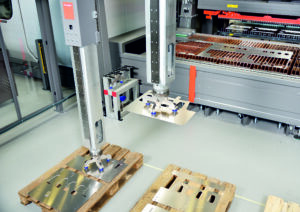
Bystronic Inc. (Hoffman Estates, IL) – Laser cutting now is far different than it was 10 or even five years ago. Advanced software features allow for autonomous cutting process optimization and monitoring, the lasers themselves have gotten more powerful, and there is an accelerating focus on automation to relieve productivity bottlenecks. Most people operating modern high-powered lasers are living in a “post inches-per-minute” world, whether they know it or not. The laser has gone from setting the pace on the shop floor, to causing a problem of too many parts in too little time! The one segment of the metal cutting market that is still enjoying tremendous gains is the thicker plate world, where 20+ kW fibers are enabling 2x-to-3x faster speeds on 5/8”, ¾”, and even 1” material.
A great deal of focus in the next few years is going to revolve around the scheduling and logistics processes that get kits of parts to robotic welding cells. These processes are mostly software driven but will utilize hardware such as sorting systems, pick and place robots, automated storage and retrieval systems, and conveyance or autonomous mobile robot systems. The software workflows must complement the hardware workflows and vice versa, compatibility across different work centers and even machine brands will become mandatory.
The perceived past of American manufacturing is associated with dirty, dangerous jobs that just will not attract good talent no matter what the pay is. Modern manufacturing companies must be focused on creating clean, automated, high technology positions that provide unique and sustainable career opportunities. A CO2 or even a standalone fiber laser that needs every part removed by hand will have a hard time finding operators (and an even harder time finding supervisors to manage the turnover of those operators), but an automated cutting and sorting cell that delivers finished stacks of parts to the next operation will find no shortage of bright young engineering-minded folks willing to manage and improve these processes.— Brendon DiVincenzo, head of solutions, market region Americas, Bystronic Inc.
Accelerating Manufacturing, Reducing Downtime, and Lowering Shop Costs
Mazak Optonics Corp. (Elgin, IL) – Laser cutting has been a cornerstone of metal fabrication for decades, revolutionizing the industry with its precision and efficiency. In recent years, the technology has experienced a significant evolution, pushing the boundaries of what’s possible in metal processing.
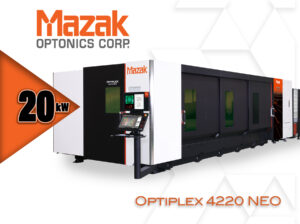
One prominent example of this advancement is the Mazak OPTIPLEX NEO with Variable Beam Parameter Product (V-BPP), a game-changing machine redefining laser cutting. Mazak listened to what our customers said — they required more than accelerated speeds and operating efficiency; they also wanted flexibility, stability, and superior part quality. One of the most remarkable aspects of the Mazak OPTIPLEX NEO is its beam shape and mode control, V-BPP. This revolutionary technology allows for faster cutting speeds, improved energy efficiency, and enhanced precision, all while being up to 3x more stable than a standard fiber laser. With V-BPP technology, the NEO can effortlessly handle a wide range of materials, from thin sheets to thick plates. NEO is available in 3015 or 4220 table sizes and comes in power levels of 4 kW up to 20 kW. Its intuitive torch head, cutting-edge software, and ease of operation make it a versatile solution for various machine shops.
The ever-increasing capacity and throughput of today’s high-powered lasers have also cemented the need for versatile, high-speed automation and material handling. Considering this need, Mazak recently introduced its latest compact and economical solution for high-performance automation, the Smart Cell 6-axis robotic sorting system. The system incorporates multiple customizable magnetic or suction cup gripper options for sorting parts, loading raw material, and removing remnants. Many other Mazak automation solutions are available to work with our laser-cutting systems, allowing them to operate 24/7. This technology accelerates manufacturing, reduces downtime, and ultimately lowers shop costs. Mazak is redefining manufacturing with innovative technologies geared for sustainable growth in the years ahead. Discover more with Mazak. — Dan Konrath, sales manager for the Southeast region, Mazak Optonics Corp.
Increased Laser Power and Assist Gases will Open up new Markets
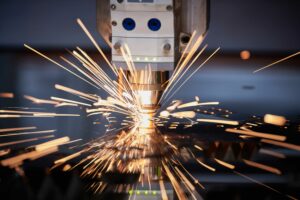
Messer Cutting Systems, Inc. (Menomonee Falls, WI) – With the advent of increasing laser power sources, the future is very “bright” for the metal fabrication world. The direct correlation between increased power and the laser cutting process in thick mild steel plate is the end user is going to be able to change from using oxygen assist gas to gases such as nitrogen, air, and mixed gases to process thick plate (mild steel). This will open up new markets that are currently being satisfied by plasma and flame cutting.
This will be a game changer as the edge quality and cutting speeds will drastically increase and eliminate the additional process of removing the oxidation layer that is created when using oxygen-assist gas. In thick plate if this layer is not removed paint will not adhere to the cut edge.
As this industry has learned through the years, the cutting head is one of the most important components of the laser cutting system. We all know the painstaking evolution process of ensuring zero contamination in the cutting head cavity. The great news is that we have cutting heads that will handle up to a 50 kW power source. This technology married with stable laser power sources will provide stable cutting processes in thick plates.
As power increases there will be significant gains in cutting speeds and acceleration in thinner sheets. In this case, height sensing units are becoming more and more responsive allowing cut speeds up to 3,500 inches per minute, in some cases. The cutting process can be so fast that without some type of automation applied to the loading and unloading of the raw material, the operator is unable to keep pace with the machine. Innovative part sorting has also become a factor in eliminating the issue of operator intervention and pauses in production due to the operator’s ability to keep pace with lightning fast cutting speeds.
The laser cutting world is evolving rapidly and the future is “bright”! — Adam Bryan, laser project manager, Messer Cutting Systems


